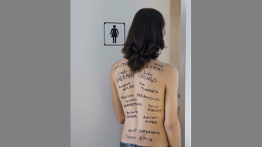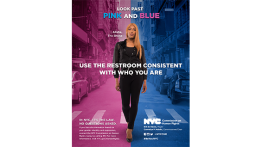Bathroom Confidential
POSTED ON: November 3, 2016
Last spring, The Cooper Union made national news when it became the first college in the country to remove gendered signs from all of its bathrooms. Acting President William Mea made the announcement in a college wide email that laid out why it was important to make this change, noting Cooper’s tradition of innovation. “We have always been ahead of our time and we must continue being leaders on issues of social justice.” Bill Mea’s decision came after extensive conversation with students who objected to the school’s bathroom signs, deeming them hostile to transgender people and anyone who doesn’t identify with binary gender categories. A group of about 50 students—cis- and transgender—had been working to change the bathroom signs for two years. Rio Sofia, now a senior in the School of Art, pointed out that violence against transgender people, particularly those who are black, Latino or indigenous, is rampant. Cooper’s de-gendered bathrooms are a simple way to minimize, if only slightly, the sorts of hazards transgender students face on a daily basis.

Ellen Lupton A’85, co-author of The Bathroom, the Kitchen and the Aesthetics of Waste with her husband, J. Abbott Miller A’85, isn’t surprised that the very practical concern of bathroom access has become a vehicle for a larger discussion about transgender equality. She says that bathrooms have frequently been the locus of human rights struggles. “Historians have shown that providing public bathrooms to women in the late 19th century and early 20th century was a big part of the women’s rights movement, because women couldn’t go to work or move about freely in society if they didn’t have access to toilets,” Lupton says. “Access to public toilets was also important to the struggle for African-American civil rights.”
Cooper announced the gender-neutral designation of a few single-occupancy bathrooms in 2014 after the Office of Student Affairs was approached by a group of students who submitted a proposal for such facilities.
Just over a year later, a major exhibition opened in the 41 Cooper Gallery. Called Bring Your Own Body, it presented work from transgender artists and archives. “Over a month of trans-centered public events, the inadequacies of the restroom policies were thrown into even sharper relief,” Stamatina Gregory, the exhibition co-organizer and associate dean of the School of Art, says. “Students’ handmade printed and laminated signs would disappear overnight, and by the end of the show, we’d hurriedly tape up sheets of notebook paper reading ‘Bathroom’ so as not to alienate our audiences. Thank-fully, Cooper students are no strangers to direct action.”
The gender-neutral designation was then expanded to several more single-occupancy bathrooms. At that point official signage became an issue. Mindy Lang A’82, Cooper’s creative director, was called on to create new signs for the de-gendered single-occupancy bathrooms. She did some research on images used to signify a “unisex” washroom, and discovered that they were miser-ably lacking. One, for instance, shows a lone figure split
vertically to indicate a half woman/half man (the former indicated by the telltale A-line skirt). She found such solutions insulting, so she settled on a sign that simply showed a toilet with the label “GENDER-NEUTRAL RESTROOM.”
Two months later, administrators organized a meeting in The Great Hall open to the entire student body to discuss concerns of the transgender community at Cooper. “The event was in response to the Joint Student Council passing a resolution asking for all restrooms to be de-gendered and then some students pushing back,” Chris Chamberlin, dean of students, says. “We brought in facilitators to help the students and campus learn about trans issues and help come up with a common language and frame the issues that the community was tackling.”
Bill Mea sent out a schoolwide email a few days after the December 2015 meet-ing, in which he noted that while some people on campus had been thinking about bathroom accessibility for years, for others the questions were new ones. He proposed that the school maintain the all-gender single-occupancy facilities as well as the male and female bathroom designations. But these last would, as he put it, “include signage noting that the restroom is open to anyone who feels that the use of that restroom matches their gender identity and also noting the location of private all-gender restrooms in that building.” He made a point of asking students to contact him to voice their opinions about his proposition.
But student activists felt this was a half measure that still didn’t address the essential issue of needlessly applying gender considerations to a public facility. They decided to pull down the existing signs, replacing them with ones of their own marked simply, “Bathroom :)” or “De-gendered.” Sarah Schmitt, now a senior in the School of Art, told The Guardian in 2016 that the Cooper administration had hesitated to change bathroom signs, arguing that the signs alone wouldn’t change how other bathroom users would treat transgender students. “And what we said was, it doesn’t really matter if it changes right away. The icon on the bathroom is no longer validating that policing.”
Instead of immediately reacting to the student-improvised signage, Bill Mea left it in place to gauge how the community reacted. What the administration discovered was that few people were uncomfortable with the change, with most choosing to use the same bathrooms they always had.
In March 2016, Mea decided that his initial response—to create universal access only for single-occupancy facilities—was a “compromise” he found to be “increas-ingly difficult to reconcile with what I believe to be right and just.” So he declared that all of the school’s bathrooms would remove gender language. It was back to the drawing board for Mindy Lang. This time around, she says, she had a better sense of why students objected to the expression “gender neutral”: it assumed that gender mattered at all. For the new signs, she expanded her research and saw that even the most progressive institutions included the word “gender” in their signs. Instead, she opted for signage that simply described the contents of the room—stalls and urinals, stalls only, or single-occupancy restrooms.
Rio Sofia is pleased with the new signs because they don’t impose anyone’s idea of what gender should or shouldn’t be. “Neutrality relies on the logic that there are two poles defining gender: male and female, masculine and feminine,” she says. “It relies on a lot of gender essentialism and erases the experiences of people who are nonbinary or intersex, as well as non-Western and indigenous people whose relationships to gender may be constructed differently.” Sofia believes that the idea of a “unisex” bathroom, while often well intended, depends on the same notions of gender as male and female ones.
While the students, faculty and staff had been blasé about the change, the international media took notice with features about Cooper’s facilities in The Chronicle of Higher Education and The Guardian, and especially on various internet discussion spaces such as Reddit.
Meanwhile, the rest of the world started catching up to The Cooper Union. In March 2016 Mayor Bill de Blasio ordered that all city-run gendered public bath-rooms guarantee access consistent with an individual’s own gender identity. In May, President Obama ordered that all public school bathrooms also guarantee access according to gender self-identity. Then in June a New York City bill was passed requiring all single-occupancy bathrooms in all public spaces, including privately owned businesses such as bars and restaurants, remove gender-specific signage.






